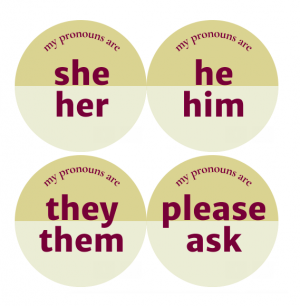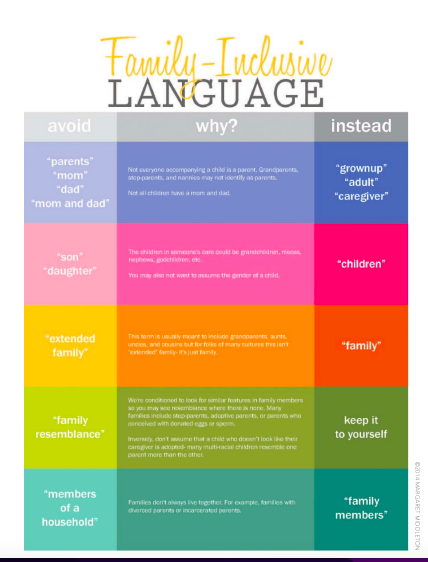Inclusive Language in Museums
Word choice matters. Words can include or exclude. Words can prescribe power or take it away. The language that museums use to communicate with their audience can create an inclusive environment and promote diverse stories, or not. Living history museums have a reputation for promoting a nostalgic version of the past and focusing on the stories of the white nuclear family, but this is beginning to change. Conversations about diversity and inclusion within all types of museums have increased in the last decade. On August 24, 2022, ICOM approved a new museum definition that includes, for the first time, phrases like “inclusivity”, “accessibility”, “diversity”, and “ethics.” In the 21st century, museums are striving to become welcoming spaces for all visitors regardless of race, religion, ethnicity, sexual orientation, gender identity, and physical ability. A significant step in this process has been the formation of internal DEAI (diversity, equity, accessibility, and inclusion) committees or workgroups.
This summer, I interned in the education department at Strawbery Banke Museum, where I increased my understanding of what inclusion can look like when working with young audiences at a living history museum. Strawbery Banke Museum is extremely forward-thinking compared to other living history museums I have visited. In 2020, the staff formed a DEAI task force and created a DEAI mission statement to guide work culture, interpretation, and audience interaction. In 2021, Strawbery Banke Museum introduced optional “she/her”, “he/him”, “they/them”, and “please ask” pronoun pins for staff to wear alongside their museum name tags. The pronoun pins are an actionable step that the museum is taking following its DEAI Task Force mission statement.

Pronoun Pins
Wearing a “she/her” pronoun pin every day, as part of my Strawbery Banke Museum uniform, was a simple yet impactful way that I chose to affirm that everyone’s identity should be valued. Wearing the pin was also a way I could invite campers into conversations about gender identity. As a general rule, we also greeted/addressed our groups as “campers” or “friends”, to avoid the greeting “boys and girls,” which assumes the group’s gender identities. In addition to the education staff wearing pronoun pins, we made them available to the summer campers. In the Victorian Jr. Roleplayers camp (12-17-year-olds) I helped implement, the pronoun pins were greatly appreciated, as several of the campers identified as non-binary. In Victorian Jr. Roleplayers, the campers engaged in historical research methods to learn about a specific “Puddle Dock” community member from the Victorian period to portray on the museum grounds. Like many living history sites, Strawbery Banke Museum’s records lack information about LGBTQIA+ community members. While there are historical primary source documents that tell these stories, traditionally they have been overlooked or buried by archives and researchers. This meant that the education team had to get creative. Without compromising historical accuracy (clothing, historical events, etc.), we created composite characters for our Jr. Roleplayers who identified as non-binary. In addition to this, we gave campers the choice of wearing female or male presenting historical clothing.
My goal for leading summer camps was not only to engage campers (6-17-year-olds) in Portsmouth community history through fun crafts and activities but to make sure all campers felt welcomed and respected while at the museum. I experienced first-hand how language choice has a huge impact on transgender or gender-non-conforming summer campers. Whether you are an emerging museum professional or a current professional, I believe we should all be striving to make diverse audiences feel welcomed, respected, and empowered in our museum spaces.

There are so many great resources out there to guide museum staff and organizations in integrating inclusive language and practices into their spaces. In 2014, Margaret Middleton, a Boston-based exhibit designer, developed a Family-Inclusive Language guide to be used as a tool for museum educators and exhibit developers. The guide provides inclusive language alternatives for problematic phrases. For example, the guide suggests using the phrase “guardians” instead of “parents”, and “children” instead of “son or daughter.” The guide prompts museum professionals to think about the bias that can be embedded in interpersonal interactions or exhibit text, such as assumed gender identity or familial relationships. The LGBTQ Alliance professional network of the American Alliance of Museums (AAM) offers an LGBTQ Welcoming Guidelines for Museums resource. The guidelines establish standards of professional practice to help museums be more inclusive of lesbian, gay, bisexual, transgender, and queer staff and visitors.
Here are the links to those two recourses, to help you start thinking about how to integrate inclusive practices into your work, department, and museum:
***
Post by Savannah Kruguer
MA Candidate: Museum Education, Tufts University